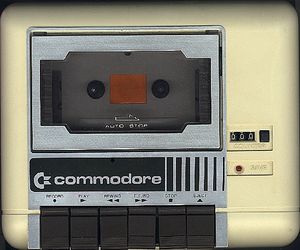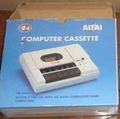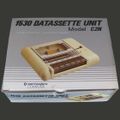Datasette
Contents
Description of Datassette
By far, the most common and popular peripheral for the VIC-20 was the C2N/1530 Datassette tape drive. While disk drives were available (the VIC-1540) was made specifically for the VIC-20), many Vic 20 owners felt that disk drives were too expensive in contrast to the relatively cheap VIC-20 home computer, with the disk drive generally costing as much as double the retail price of the VIC-20 when initially released. The Datassette was priced more in line with a VIC-20 - generally costing about half of what the computer cost new. It provided reliable data storage and retrieval on commonly available Compact Cassette audio tapes. While data storage and retrieval was considered slow, a stock VIC-20 computer only had 3.5k available, which meant that the programs written for it were small. As such, for a stock VIC-20 home computer the performance of the Datassette was acceptable.
The VIC-20 is compatible with the same Datassettes used on the Commodore PET computer. In fact, the first Datassette released by Commodore for the VIC-20 was identical to the PET model, except moulded in white plastic to match the VIC-20's case. This same Datassette was also compatible with the Commodore 64; successor to the VIC-20. All these computers shared the same cassette tape port. Many people who upgraded from the VIC-20 to the Commodore 64 reused their Datassettes. When loading the much more RAM intensive programs of the Commodore 64 the slow speed of the Datassette became quite apparent. This helped to drive sales of Commodore's 1541 disk drive, an improved but functionally nearly identical version of the VIC-1540.
In spite of the popularity of the Datassette among VIC-20 computer users, many commercial titles continued to be released as cartridges in order to avoid the stock VIC-20's 3.5k memory limit. However, with memory expansion, a VIC-20 could load many of these same games from tape.
The Commodore 1530* (C2N) Datassette (a portmanteau of data + cassette), was Commodore's dedicated computer tape recorder. It provided access to an inexpensive storage medium for Commodore's 8-bit home/personal computers, notably the PET, VIC-20, and C64.
Confusingly, the Datassette at various times was sold both as the C2N DATASETTE UNIT Model 1530 and as the 1530 DATASSETTE UNIT Model C2N. Note the difference in spelling (one versus two s 'es) used on the original product packaging. The C2N / single-"S" Datassette designation seems to be the earlier one - keeping in line with the product number used for the PET computer.
Technical
The Datassette contained built-in A/D converters and audio filters to convert the computer's digital information into analog sound and vice versa (much like a modem does over a telephone line). Connection to the computer was done via a standard 2 x 6 pins with .156" spacing edge connector of which only the upper half was effectively connected. The absence of recordable audio signals on this interface made the Datassette and its few clones the only cassette recorders usable with CBM's machines, until aftermarket converters made the use of ordinary recorders possible.
The inexpensive and widely available audio cassettes made the Datassette a good choice for the budget-aware home computer mass market. In Europe, the Datassette was the medium of choice for several years after its launch, although floppy disk drives were generally available. In the U.S., however, disk drives quickly became standard, despite the Commodore 1541 floppy drive costing roughly 5 times as much as a Datassette.
The Datassette was a very slow and fairly unreliable medium (the latter caused by the sensitivity of the encoded analog signal to disturbances by magnetic fields and tape failure). Contemporary disk drives were an order of magnitude faster and more reliable. Some years after the Datassette's launch, however, special turbo tape compression software appeared, providing much faster tape operation (loading and saving). Such software was available for loading commercial prerecorded applications (mostly games), as well as for loading and saving the users' homemade programs and data.
Datassettes could typically store about 200 KB (100+ KB per 30 minute side, [1]).
Models & Variations
The main types of datassettes used with the VIC-20 are listed below. The first was made as a PET peripheral and styled after the PET 2001 built-in tape drive. The latter two were styled and marketed for the VIC-20 and C64. All 1530s were compatible with all these computers, as well as the C128.
- External black body, original shape model with black cassette lid, five black keys, no tape counter, no SAVE LED. This black model is officially a PET peripheral, but worked with the VIC.
- External white body, identical in shape to PET model but moulded in white plastic to match the VIC-20, transparent tan cassette lid, five dark brown keys, with tape counter, no SAVE LED
- External white body, square shaped model with rounded corners, six dark brown keys, with tape counter and a red SAVE LED. Minor decorative variations existed, ranging from a plain silver to brown "banding" on and around the cassette lid. Size and colour of the numbers in the tape counter window varied. Variants appeared with and without save LED.
A later model, the charcoal coloured 1531, was marketed for the Commodore-16/+4 line. This model could also work with the VIC-20 (although it required a connection adaptor).
Some models of datassette had a small hole above the keys to allow access to the azimuth adjustment screw of the tape head. A small screwdriver could thus easily be used to effect the adjustment without disassembling the Datassette's chassis.
Third-party Datassette 'clones'
Several third-party companies released "clone" datassettes which functioned in an identical manner as their Commodore counterparts. It seems that several companies distributed the same type of clone datassette under their own brand name.













